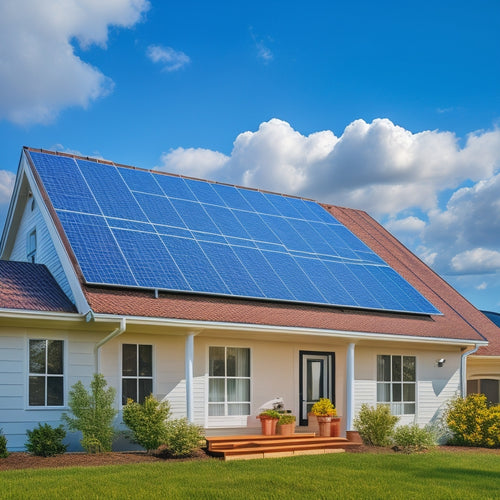
Heating Your Pool With Renewable Energy
Share
You can greatly reduce your pool's carbon footprint and energy costs by switching to renewable energy sources. Solar power, in particular, offers a cost-effective and eco-friendly solution, providing up to 75% reduction in carbon emissions. By utilizing the sun's energy, you'll not only minimize your environmental impact but also save hundreds of dollars on energy bills each year. With solar panels, you'll enjoy extended swimming seasons, energy independence, and a potential increase in property value. Now that you've taken the first step towards a greener pool, you're ready to explore deeper into the world of solar pool heating and access its full potential.
Overview
- Solar pool heating reduces environmental impact and carbon footprint while providing cost savings and extended swimming seasons.
- High-efficiency solar panels can enhance energy output by up to 45% with proper installation and orientation.
- Reflective surfaces beneath photovoltaic cells can increase energy production by 10-15% by redirecting stray sunlight.
- Solar energy offers zero operating costs and long-term savings, offsetting the initial investment over time.
- Evaluating pool size, climate, and usage patterns is essential to determine heating requirements and maximize energy savings potential.
Benefits of Solar Pool Heating
When considering a heating solution for your pool, utilizing the power of the sun can be a wise decision. By utilizing solar energy, you'll greatly reduce your environmental impact and carbon footprint, contributing to climate action.
This eco-friendly approach also translates to cost savings, as you'll rely less on traditional heating methods, and can even increase your property value by up to $15,000.
With solar pool heating, you can extend your swimming season, enjoying your pool for a longer period. Additionally, you'll gain energy independence, reducing your reliance on public utilities.
As a result, your property value will increase, and you'll experience a seamless user experience.
Understanding Solar Panel Efficiency
You'll get the most out of your solar panel system by optimizing its efficiency, and that starts with understanding the key factors that impact its performance.
The angle at which you install your panels, the type of solar cells you use, and the reflective surface surrounding them all play a critical role in maximizing energy output.
High-efficiency panels can enhance energy output by up to 45% via optimized angles and tilt Future-Proof Systems, making them an attractive option for those looking to heat their pool with renewable energy.
Panel Angle Matters
By mid-morning, the sun's rays have already begun to strike your solar panels at an angle, making it crucial to optimize their position for maximum energy harvesting.
High-efficiency silicon solar cells, which can achieve conversion rates over 26% high-efficiency energy conversion, can greatly enhance your energy output.
You need to adjust your panel orientation to match the sun's seasonal movements. During summer, the sun is higher in the sky, so you should tilt your panels at a steeper angle to maximize energy output.
In winter, the sun is lower, so a shallower angle is more suitable.
Make seasonal adjustments to your panel orientation to guarantee you're generating the most energy possible.
Proper panel angle optimization can increase energy production by up to 45%, giving you the freedom to enjoy your pool at the perfect temperature while minimizing your carbon footprint.
Cell Type Efficiency
Three primary types of solar cells dominate the market: monocrystalline, polycrystalline, and thin-film. You'll want to understand their differences to maximize your solar panel's efficiency. Efficiency metrics, such as peak sun hours and temperature coefficient, vary among cell types.
| Cell Type | Efficiency Range | Average Cost per Watt |
|---|---|---|
| Monocrystalline | 15-20% | $2.50-$3.50 |
| Polycrystalline | 12-15% | $2.00-$3.00 |
| Thin-Film | 7-14% | $1.50-$2.50 |
When choosing a solar panel, consider the trade-off between efficiency and cost. While monocrystalline cells offer higher efficiency, they come at a higher price. Thin-film cells, on the other hand, provide a more affordable option, but with lower efficiency.
Reflective Surface Boost
Most solar panels are designed with a reflective surface beneath the photovoltaic cells to enhance their efficiency.
This reflective surface, often made of reflective materials, helps redirect stray sunlight onto the photovoltaic cells, increasing energy production. By adding a reflective surface, you can expect an increase in energy output, typically ranging from 10% to 15%.
Surface coatings, such as aluminum or silver, are commonly used to create this reflective surface. These coatings can be applied to the panel's backsheet or encapsulant, allowing for ideal reflection of light.
Home Solar Panel Costs Explained
With solar energy becoming an increasingly viable option for heating your pool, understanding the costs associated with installing a home solar panel system is essential.
You'll need to evaluate the upfront cost of the solar panels, inverters, and installation. However, there are ways to offset these costs.
You can take advantage of solar panel incentives, such as the federal solar investment tax credit, which allows you to claim a percentage of the total cost as a tax credit.
Additionally, examine financing options like solar loans or power purchase agreements to spread the cost over time.
Installation and Maintenance Tips
When installing a renewable energy pool heating system, you'll need to conduct a thorough site assessment to determine the ideal system size and configuration.
Getting this step right is vital, as it directly impacts your system's efficiency and overall performance.
Site Assessment Matters
Your pool's unique characteristics and surroundings play an essential role in determining the effectiveness of a renewable energy heating system.
During the site evaluation, consider factors like pool size, shape, and location, as well as surrounding structures that may affect wind patterns or shading.
Assess the environmental impact of your system by evaluating the available space for equipment installation and ensuring that it won't obstruct your outdoor living area.
You'll also want to evaluate the local building codes, permits, and regulations that may affect your system's design and installation.
A thorough site assessment will help you optimize your renewable energy heating system, ensuring it operates efficiently and effectively.
System Sizing Essentials
Properly sizing your renewable energy heating system is crucial to its performance, as an undersized system will struggle to heat your pool, while an oversized system will waste energy and increase costs.
You'll want to take into account factors like your pool's size, insulation, and desired temperature to determine the required energy output.
A system that's too small won't provide adequate heat, while one that's too large will be inefficient and costly.
By accurately sizing your system, you'll enhance its performance, reduce energy consumption, and enjoy a warm and comfortable pool experience.
Confirm you work with a qualified professional to determine the ideal system size for your specific needs and achieve peak system performance.
Ongoing Maintenance Needs
After determining the ideal system size, it's time to focus on guaranteeing your renewable energy heating system operates at peak performance over its lifespan.
You'll need to perform regular filter maintenance, pump upkeep, and equipment checks to prevent algae growth and maintain peak water chemistry.
Implement winterization strategies to protect your system during the off-season. Conduct regular system monitoring and seasonal adjustments to maximize energy efficiency.
Remove debris from your system regularly to prevent clogs and damage. Consider conducting energy audits to identify areas for improvement.
Comparing Solar to Traditional Heating
Beyond the allure of cost savings, pool owners are increasingly drawn to renewable energy sources for their eco-friendly benefits. When it comes to heating your pool, you're likely considering the pros and cons of traditional heating systems against solar energy.
| Traditional Heating | Solar Energy |
|---|---|
| High operating costs | Zero operating costs |
| Contributes to greenhouse gas emissions | Zero emissions, eco-friendly |
| Limited lifespan (10-15 years) | Long-lasting (20-30 years) |
| Noise pollution from equipment | Silent operation |
In terms of solar energy advantages, you'll enjoy zero operating costs and a considerable reduced carbon footprint. On the other hand, traditional heating drawbacks include high operating costs, noise pollution, and a limited lifespan. By choosing solar energy, you're not only saving money but also doing your part for the environment.
Pool Size and Heating Requirements
As you weigh the benefits of solar energy for your pool, it's crucial to reflect on the specific heating requirements of your pool.
Your pool's dimensions play a significant role in determining its heating needs. A larger pool requires more energy to heat, while a smaller pool needs less.
Climate considerations also come into play, as pools in colder regions need more heat to maintain a comfortable temperature.
You'll need to evaluate your pool's surface area, volume, and location to determine its unique heating requirements.
Maximizing Energy Savings Potential
How much can you realistically expect to save on energy costs by switching to a solar-powered pool heating system? The answer lies in maximizing your energy savings potential.
To do this, you'll need to take into account climate considerations, such as the number of sunny days in your area, and usage patterns, like how often you use your pool. Proper insulation techniques, like using a high-efficiency pool cover, can also help reduce heat loss.
Additionally, implementing energy storage solutions, like batteries, can guarantee a steady supply of energy even on cloudy days. By regulating temperature and optimizing heat retention, you can minimize energy waste and enjoy significant savings.
Frequently Asked Questions
Can I Install Solar Panels on My Existing Pool Equipment?
You can install solar panels on your existing pool equipment, but first, you'll need to verify compatibility by checking the equipment's electrical specs and structural integrity to support the added weight and size of the solar panel installation.
How Long Does a Solar Pool Heating System Last?
You can expect a solar panel lifespan of 20-30 years, but it's essential to perform regular maintenance, like cleaning and inspecting, to guarantee peak performance and extend its life, giving you years of hassle-free energy independence.
Are Solar Pool Heaters Eligible for Government Incentives?
You'll be pleased to know that 30% of solar pool heater costs are eligible for federal tax credits, making solar incentives a significant perk for eco-conscious pool owners who opt for renewable energy solutions.
Can I Use Solar Panels to Heat My Hot Tub or Spa?
You can use solar panels to heat your hot tub or spa, optimizing hot tub efficiency by choosing the right solar panel types, such as evacuated tube or flat-plate collectors, to suit your climate and energy needs.
Will Solar Panels Affect My Pool's Aesthetic Appeal?
As you envision your backyard oasis, you wonder if solar panels will be an eyesore. Fear not! Modern solar panel design prioritizes aesthetic integration, blending seamlessly with your pool's surroundings, preserving its visual appeal while utilizing renewable energy.
Ready to Buy
Congratulations, you've finally decided to join the 21st century and ditch that fossil fuel-guzzling pool heater. Now, you can bask in the warm glow of your solar-heated pool, knowing you're saving the planet (and some serious cash) in the process. Pat yourself on the back, eco-warrior. Just don't get too comfortable – you've still got to worry about optimizing your system, monitoring energy output, and performing routine maintenance. But hey, someone's gotta save the planet, right?
Related Posts
-

Cost of Solar Panel Installation
You can expect to pay between $15,000 and $30,000 or more for a typical solar panel installation, depending on the sy...
-

Designing a Green Roof for Maximum Energy Efficiency
Designing a green roof for maximum energy efficiency involves several key strategies. Start by selecting native, drou...
-

Choosing the Right Solar Power Charge Controller
Choosing the right solar power charge controller is crucial for maximizing energy efficiency and extending battery li...


